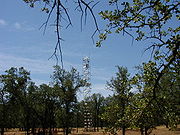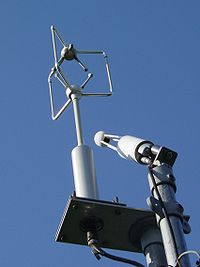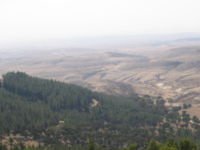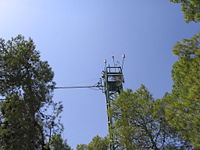
FluxNet
Encyclopedia

Eddy covariance
The eddy covariance technique is a key atmospheric flux measurement technique to measure and calculate vertical turbulent fluxes within atmospheric boundary layers...
methods to measure the exchanges of carbon dioxide
Carbon dioxide
Carbon dioxide is a naturally occurring chemical compound composed of two oxygen atoms covalently bonded to a single carbon atom...
, water vapor
Water vapor
Water vapor or water vapour , also aqueous vapor, is the gas phase of water. It is one state of water within the hydrosphere. Water vapor can be produced from the evaporation or boiling of liquid water or from the sublimation of ice. Under typical atmospheric conditions, water vapor is continuously...
, and energy between the biosphere
Biosphere
The biosphere is the global sum of all ecosystems. It can also be called the zone of life on Earth, a closed and self-regulating system...
and atmosphere
Atmosphere
An atmosphere is a layer of gases that may surround a material body of sufficient mass, and that is held in place by the gravity of the body. An atmosphere may be retained for a longer duration, if the gravity is high and the atmosphere's temperature is low...
. Fluxnet is a global 'network of regional networks' that serves to provide an infrastructure to compile, archive and distribute data for the scientific community. It works to ensure that different flux networks are calibrated to facilitate comparison between sites, and it provides a forum for the distribution of knowledge and data between scientists.
As of January 2009, there are over 500 tower sites in continuous long-term operation. Researchers also collect data on site vegetation
Vegetation
Vegetation is a general term for the plant life of a region; it refers to the ground cover provided by plants. It is a general term, without specific reference to particular taxa, life forms, structure, spatial extent, or any other specific botanical or geographic characteristics. It is broader...
, soil
Soil
Soil is a natural body consisting of layers of mineral constituents of variable thicknesses, which differ from the parent materials in their morphological, physical, chemical, and mineralogical characteristics...
, trace gas fluxes, hydrology, and meteorological characteristics at the tower sites.
Scientific goals

- To "quantify the spatial differences in carbon dioxide and water vapor exchange rates that may be experienced within and across natural ecosystems and climatic gradients"
- To "quantify temporal dynamics and variability (seasonal, inter-annual) of carbon, water and energy flux densities; such data allows us to examine the influences of phenology, droughts, heat spells, El Nino, length of growing season and presence or absence of snow on canopy-scale fluxes"
- To "quantify the variations of carbon dioxide and water vapor fluxes due to changes in insolation, temperature, soil moisture, photosynthetic capacity, nutrition, canopy structure and ecosystem functional type."
History

John Monteith
John Lennox Monteith DSc, FRS, born September 3, 1929 in Ayrshire, Scotland, is a leading authority in the related fields of water management for agricultural production, soil physics, micrometeorology, transpiration, and the influence of the natural environment on field crops, horticultural crops,...
used the "flux gradient" method to make semi-accurate assessments of the fluxes in a variety of natural settings. The work of scientists such as Monteith
John Monteith
John Lennox Monteith DSc, FRS, born September 3, 1929 in Ayrshire, Scotland, is a leading authority in the related fields of water management for agricultural production, soil physics, micrometeorology, transpiration, and the influence of the natural environment on field crops, horticultural crops,...
realized that the Flux Gradient method was not nearly as accurate as it needed to be when used to measure trace gas
Trace gas
A trace gas is a gas which makes up less than 1% by volume of the Earth's atmosphere, and it includes all gases except nitrogen and oxygen . The most abundant trace gas at 0.934% is argon, which is being continually produced by radioactive decay of in the earth's rocks...
exchange in tall forests. Eventually, they realized that the downfall of their models was caused by "large scale transport in the roughness sublayer". The reason for these data inaccuracies was hypothesized to arise from Monin-Obukhov
Monin-Obukhov Length
The is used to describe the effects of buoyancy on turbulent flows, particularly in the lower tenth of the atmospheric boundary layer. It was first defined by Alexander Obukhov in 1946,...
scaling theory.
As digital technology advanced throughout the 1970s and 80s, so did advances in the sensors and digital hardware necessary to provide the means to make advanced measurements of fluxes with what became known as the eddy covariance
Eddy covariance
The eddy covariance technique is a key atmospheric flux measurement technique to measure and calculate vertical turbulent fluxes within atmospheric boundary layers...
technique. With this method as well as further advances in digital data storage
Data storage device
thumb|200px|right|A reel-to-reel tape recorder .The magnetic tape is a data storage medium. The recorder is data storage equipment using a portable medium to store the data....
, it became possible for curious scientists to make these eddy flux measurements for long periods of time and consequently get a sense of annual carbon dioxide
Carbon dioxide
Carbon dioxide is a naturally occurring chemical compound composed of two oxygen atoms covalently bonded to a single carbon atom...
and water vapor
Water vapor
Water vapor or water vapour , also aqueous vapor, is the gas phase of water. It is one state of water within the hydrosphere. Water vapor can be produced from the evaporation or boiling of liquid water or from the sublimation of ice. Under typical atmospheric conditions, water vapor is continuously...
changes in the biosphere. As these techniques became more widespread in the scientific community, more research groups took the initiative to establish further measurement sites. Eventually, enough sites were established to allow research of fluxes over wide areas of land with the help of multiple investigators. An example of such a study is the "Boreal Ecosystem-Atmosphere Study".
With the success of such projects, participating scientists began to explore the idea of creating a global
World
World is a common name for the whole of human civilization, specifically human experience, history, or the human condition in general, worldwide, i.e. anywhere on Earth....
network
Computer network
A computer network, often simply referred to as a network, is a collection of hardware components and computers interconnected by communication channels that allow sharing of resources and information....
of sensor sites that could be used to integrate their data and provide access for the members of the academic community and general public
Public
In public relations and communication science, publics are groups of individuals, and the public is the totality of such groupings. This is a different concept to the sociological concept of the Öffentlichkeit or public sphere. The concept of a public has also been defined in political science,...
. At a meeting in La Thuile, Italy during 1995, contributing scientists began to discuss the feasibility of such a network. With the successful conclusion of this meeting, there was an increase in the rate of sensor site installation and the growth of regional networks. Eventually, the Euroflux network took hold in 1996 and was soon followed by the AmeriFlux network in 1997. When NASA
NASA
The National Aeronautics and Space Administration is the agency of the United States government that is responsible for the nation's civilian space program and for aeronautics and aerospace research...
saw the enthusiasm from the scientific community for these two networks as well as the possibility to integrate trace gas data from the ground with data from the Earth Observatory Satellite
Terra (satellite)
Terra is a multi-national NASA scientific research satellite in a sun-synchronous orbit around the Earth. It is the flagship of the Earth Observing System...
, it finally funded the Fluxnet project as a whole in 1998.
In 2002, Fluxnet was added to the NOAA Observing System Architecture
NOAA Observing System Architecture
*The NOAA Observing System Architecture is a collection of over 100 of NOAA's environmental datasets.*NOSA was established to develop an observational architecture that helps NOAA:...
(NOSA).
Future site planning

Data
The term data refers to qualitative or quantitative attributes of a variable or set of variables. Data are typically the results of measurements and can be the basis of graphs, images, or observations of a set of variables. Data are often viewed as the lowest level of abstraction from which...
. With the current model used to determine flux between the surface and the atmosphere
Atmosphere
An atmosphere is a layer of gases that may surround a material body of sufficient mass, and that is held in place by the gravity of the body. An atmosphere may be retained for a longer duration, if the gravity is high and the atmosphere's temperature is low...
, it is desirable to situate the tower in an area with uniform vegetative
Vegetation
Vegetation is a general term for the plant life of a region; it refers to the ground cover provided by plants. It is a general term, without specific reference to particular taxa, life forms, structure, spatial extent, or any other specific botanical or geographic characteristics. It is broader...
cover and minimal disturbances in the terrain. Deviations in terrain
Terrain
Terrain, or land relief, is the vertical and horizontal dimension of land surface. When relief is described underwater, the term bathymetry is used...
or plant cover would prevent a constant gas flux along the height of the tower.
Another very important part of the sensor
Sensor
A sensor is a device that measures a physical quantity and converts it into a signal which can be read by an observer or by an instrument. For example, a mercury-in-glass thermometer converts the measured temperature into expansion and contraction of a liquid which can be read on a calibrated...
array is the tower on which it rests. The sensor tower must fit within a certain design criteria dependent on:
- the height of the vegetation in the area
- the averageAverageIn mathematics, an average, or central tendency of a data set is a measure of the "middle" value of the data set. Average is one form of central tendency. Not all central tendencies should be considered definitions of average....
wind speedWind speedWind speed, or wind velocity, is a fundamental atmospheric rate.Wind speed affects weather forecasting, aircraft and maritime operations, construction projects, growth and metabolism rate of many plant species, and countless other implications.... - the sampling time of the sensors
Typically, investigators who are monitoring fluxes in agricultural cropland place their sensors close to the ground. Meanwhile, scientists who hope to measure the fluxes in tall forests must place their sensors on relatively high scaffolding
Scaffolding
Scaffolding is a temporary structure used to support people and material in the construction or repair of buildings and other large structures. It is usually a modular system of metal pipes or tubes, although it can be from other materials...
. The difference in sizes is attributed to the boundary layer
Boundary layer
In physics and fluid mechanics, a boundary layer is that layer of fluid in the immediate vicinity of a bounding surface where effects of viscosity of the fluid are considered in detail. In the Earth's atmosphere, the planetary boundary layer is the air layer near the ground affected by diurnal...
s that form close to the ground because of the vegetation.
To minimize turbulence
Turbulence
In fluid dynamics, turbulence or turbulent flow is a flow regime characterized by chaotic and stochastic property changes. This includes low momentum diffusion, high momentum convection, and rapid variation of pressure and velocity in space and time...
from the tower itself, instrumentation is often placed at the top of the tower and offset several feet with the help of booms.
Instrumentation and data processing

Concentration
In chemistry, concentration is defined as the abundance of a constituent divided by the total volume of a mixture. Four types can be distinguished: mass concentration, molar concentration, number concentration, and volume concentration...
of the trace gases in question. To obtain the necessary data
Data
The term data refers to qualitative or quantitative attributes of a variable or set of variables. Data are typically the results of measurements and can be the basis of graphs, images, or observations of a set of variables. Data are often viewed as the lowest level of abstraction from which...
, it is common for the towers to employ a sonic anemometer, an infrared gas analyzer
Infrared gas analyzer
]An infrared gas analyzer measures trace gases by determining the absorption of an emitted infrared light source through a certain air sample. Trace gases found in the Earth's atmosphere get excited under specific wavelengths found in the infrared range. The concept behind the technology can be...
and some sensor to measure humidity
Hygrometer
A hygrometer is an instrument used for measuring the moisture content in the environmental air, or humidity. Most measurement devices usually rely on measurements of some other quantity such as temperature, pressure, mass or a mechanical or electrical change in a substance as moisture is absorbed...
. These tools are necessary because they provide the necessary variables to be put into the eddy covariance model of gas flux in the biosphere.
The principle behind the eddy covariance technique is that parcels of air have eddy
Eddy (fluid dynamics)
In fluid dynamics, an eddy is the swirling of a fluid and the reverse current created when the fluid flows past an obstacle. The moving fluid creates a space devoid of downstream-flowing fluid on the downstream side of the object...
like characteristics in the atmosphere
Atmosphere
An atmosphere is a layer of gases that may surround a material body of sufficient mass, and that is held in place by the gravity of the body. An atmosphere may be retained for a longer duration, if the gravity is high and the atmosphere's temperature is low...
. In other words, when trace gases are respired by vegetation
Vegetation
Vegetation is a general term for the plant life of a region; it refers to the ground cover provided by plants. It is a general term, without specific reference to particular taxa, life forms, structure, spatial extent, or any other specific botanical or geographic characteristics. It is broader...
, their velocity
Velocity
In physics, velocity is speed in a given direction. Speed describes only how fast an object is moving, whereas velocity gives both the speed and direction of the object's motion. To have a constant velocity, an object must have a constant speed and motion in a constant direction. Constant ...
can be represented by a 3D vector. The purpose of using such a precise anemometer is to measure value of the wind velocity component in three dimensions. Using the infrared gas analyzer and the humidity sensor, the concentration
Concentration
In chemistry, concentration is defined as the abundance of a constituent divided by the total volume of a mixture. Four types can be distinguished: mass concentration, molar concentration, number concentration, and volume concentration...
of water vapor and trace gases in the air sample
Sample (material)
In general, a sample is a limited quantity of something which is intended to be similar to and represent a larger amount of that thing. The things could be countable objects such as individual items available as units for sale, or a material not countable as individual items. Samples of countable...
is measured and sent to a computer which quickly figures out the mass flux of the gas in question. This mass flux makes the FluxNet project a valuable tool to scientists trying to monitor long term changes in trace gas flux within the atmosphere.
Many different forms of anemometer exist on the current market. Unfortunately, the majority of the anemometers can only measure wind
Wind
Wind is the flow of gases on a large scale. On Earth, wind consists of the bulk movement of air. In outer space, solar wind is the movement of gases or charged particles from the sun through space, while planetary wind is the outgassing of light chemical elements from a planet's atmosphere into space...
velocity in one plane and require a certain start-up wind speed. Sonic anemometers are solid state
Solid state (electronics)
Solid-state electronics are those circuits or devices built entirely from solid materials and in which the electrons, or other charge carriers, are confined entirely within the solid material...
devices that measure the wind speed by passing ultrasonic sound waves through the moving air. As wind speed changes, so does the air density
Density
The mass density or density of a material is defined as its mass per unit volume. The symbol most often used for density is ρ . In some cases , density is also defined as its weight per unit volume; although, this quantity is more properly called specific weight...
and when the density changes, so does the speed of sound
Speed of sound
The speed of sound is the distance travelled during a unit of time by a sound wave propagating through an elastic medium. In dry air at , the speed of sound is . This is , or about one kilometer in three seconds or approximately one mile in five seconds....
. By measuring the change in time it takes for the ultrasonic
Ultrasound
Ultrasound is cyclic sound pressure with a frequency greater than the upper limit of human hearing. Ultrasound is thus not separated from "normal" sound based on differences in physical properties, only the fact that humans cannot hear it. Although this limit varies from person to person, it is...
sound wave to make its way from the emitter
Emitter
-In general:*A device used to exude any signal, beacon, light, odor, liquid, fragrance, ionizing particles or any other type of signal.-In horticulture:*A device used in drip irrigation.-In electronics and instrument physics:...
to the sensor
Sensor
A sensor is a device that measures a physical quantity and converts it into a signal which can be read by an observer or by an instrument. For example, a mercury-in-glass thermometer converts the measured temperature into expansion and contraction of a liquid which can be read on a calibrated...
, the sonic anemometer can measure the total air speed as well as its direction.

Infrared
Infrared light is electromagnetic radiation with a wavelength longer than that of visible light, measured from the nominal edge of visible red light at 0.74 micrometres , and extending conventionally to 300 µm...
light is absorbed by a variety of gases at different wavelengths within the spectrum including methane
Methane
Methane is a chemical compound with the chemical formula . It is the simplest alkane, the principal component of natural gas, and probably the most abundant organic compound on earth. The relative abundance of methane makes it an attractive fuel...
, carbon monoxide
Carbon monoxide
Carbon monoxide , also called carbonous oxide, is a colorless, odorless, and tasteless gas that is slightly lighter than air. It is highly toxic to humans and animals in higher quantities, although it is also produced in normal animal metabolism in low quantities, and is thought to have some normal...
, carbon dioxide
Carbon dioxide
Carbon dioxide is a naturally occurring chemical compound composed of two oxygen atoms covalently bonded to a single carbon atom...
and oxygen
Oxygen
Oxygen is the element with atomic number 8 and represented by the symbol O. Its name derives from the Greek roots ὀξύς and -γενής , because at the time of naming, it was mistakenly thought that all acids required oxygen in their composition...
. To measure the concentration, a beam of light
Light
Light or visible light is electromagnetic radiation that is visible to the human eye, and is responsible for the sense of sight. Visible light has wavelength in a range from about 380 nanometres to about 740 nm, with a frequency range of about 405 THz to 790 THz...
is emitted into the air sample. By measuring the difference between the input and output of the infrared beam, the sensor can determine the amount of the trace gases in the sample. It is common for an infrared gas analyzer to have two configurations. The "open design" operates by shooting a beam of infrared light through the air outside of the sensor body. Meanwhile, the closed design works by sucking air into the sensor body measuring the concentration of trace gases inside of a sealed
Seal (mechanical)
A mechanical seal is a device which helps join systems or mechanisms together by preventing leakage , containing pressure, or excluding contamination...
chamber. Usually, open sensors are placed within half a meter of the anemometer while closed sensors use a collection tube mounted inside the anemometer to get their air sample.
The hygrogemeter is an essential tool used to figure out the concentration of water vapor
Water vapor
Water vapor or water vapour , also aqueous vapor, is the gas phase of water. It is one state of water within the hydrosphere. Water vapor can be produced from the evaporation or boiling of liquid water or from the sublimation of ice. Under typical atmospheric conditions, water vapor is continuously...
in the air. Unfortunately, water vapor absorbs several frequencies of light in the infrared range and most of these bands overlap that of the trace gases. Without accounting for water vapor, the Infrared gas analyzer would give false data. To solve this problem, an accurate water vapor measurement is needed. Solid state
Solid state
Solid state may refer to:In science:* Solid-state chemistry* Solid-state physics* Solid-state laser* Solid matterIn electronics:* Solid state , circuits built of solid materials* Solid-state fan...
hygrometers are designed to have two metal plates separated by a small air gap. Differing levels of humidity
Humidity
Humidity is a term for the amount of water vapor in the air, and can refer to any one of several measurements of humidity. Formally, humid air is not "moist air" but a mixture of water vapor and other constituents of air, and humidity is defined in terms of the water content of this mixture,...
in the air change the capacitance
Capacitance
In electromagnetism and electronics, capacitance is the ability of a capacitor to store energy in an electric field. Capacitance is also a measure of the amount of electric potential energy stored for a given electric potential. A common form of energy storage device is a parallel-plate capacitor...
of the air gap. This can be measured by applying a high frequency AC voltage to the plates and measuring the capacitance through an RC circuit
RC circuit
A resistor–capacitor circuit ', or RC filter or RC network, is an electric circuit composed of resistors and capacitors driven by a voltage or current source...
.
Yatir Forest, Israel


Afforestation
Afforestation is the establishment of a forest or stand of trees in an area where there was no forest. Reforestation is the reestablishment of forest cover, either naturally or artificially...
the Negev
Negev
The Negev is a desert and semidesert region of southern Israel. The Arabs, including the native Bedouin population of the region, refer to the desert as al-Naqab. The origin of the word Neghebh is from the Hebrew root denoting 'dry'...
desert, which accounts for 60% of the country's land mass but remains sparsely populated. The Yatir Forest
Yatir Forest
Yatir Forest is a forest in Israel, located on the southern slopes of Mount Hebron, on the edge of the Negev Desert. The forest covers an area of 30,000 dunams , and is the largest planted forest in Israel.-History:...
is located on the southern slopes of Mount Hebron
Mount Hebron
Mount Hebron is a geographic region and geologic formation in the southern West Bank, with its western foothills extending into Israel. The area was in biblical times a center of the Israelite and Hasmonean kingdoms. The region lends its name to the Mount Hebron Regional Council....
, on the edge of the Negev
Negev
The Negev is a desert and semidesert region of southern Israel. The Arabs, including the native Bedouin population of the region, refer to the desert as al-Naqab. The origin of the word Neghebh is from the Hebrew root denoting 'dry'...
Desert. Covering an area of 30,000 dunam
Dunam
A dunam or dönüm, dunum, donum, dynym, dulum was a non-SI unit of land area used in the Ottoman Empire and representing the amount of land that can be plowed in a day; its value varied from 900–2500 m²...
s (30 square kilometers), it is the largest planted forest in Israel. It is named after the ancient Levite
Levite
In Jewish tradition, a Levite is a member of the Hebrew tribe of Levi. When Joshua led the Israelites into the land of Canaan, the Levites were the only Israelite tribe that received cities but were not allowed to be landowners "because the Lord the God of Israel himself is their inheritance"...
city within its territory, Yatir
Jattir
Jattir was a town in ancient Israel.)Jattir was located in the mountainous land of Judah. It was made a levitical town for priests to live. David gave some of the spoils from his battle with the Amalekite's . )Jattir is identified with Khirbet Attir southwest of Hebron....
, as written in the Torah
Torah
Torah- A scroll containing the first five books of the BibleThe Torah , is name given by Jews to the first five books of the bible—Genesis , Exodus , Leviticus , Numbers and Deuteronomy Torah- A scroll containing the first five books of the BibleThe Torah , is name given by Jews to the first five...
The Yatir forest is a tower site of NASA
NASA
The National Aeronautics and Space Administration is the agency of the United States government that is responsible for the nation's civilian space program and for aeronautics and aerospace research...
s research project FluxNet.
There is a multitude of modern Israeli scientific research conducted in the Yatir Forest to meet the challenge of climate change
Climate change
Climate change is a significant and lasting change in the statistical distribution of weather patterns over periods ranging from decades to millions of years. It may be a change in average weather conditions or the distribution of events around that average...
, which may result in rapid plant loss and desertification in certain circumstances. Studies of the Weizmann Institute of Science
Weizmann Institute of Science
The Weizmann Institute of Science , known as Machon Weizmann, is a university and research institute in Rehovot, Israel. It differs from other Israeli universities in that it offers only graduate and post-graduate studies in the sciences....
, in collaboration with the Desert Research Institute at Sde Boker
Sde Boker
Sde Boker is a kibbutz in the Negev desert of southern Israel. Best known as the retirement home of Israel's first Prime Minister, David Ben-Gurion, it falls under the jurisdiction of Ramat HaNegev Regional Council.-History:...
, have shown that the trees function as a trap for carbon in the air. Shade provided by trees planted in the desert also reduces evaporation of the sparse rainfall. Arava Institute for Environmental Studies
Arava Institute for Environmental Studies
The Arava Institute for Environmental Studies is an accredited academic program for undergraduate and graduate studies located at Kibbutz Ketura on the Israeli side of the Arava Valley. It seeks to train future leaders of the Middle East in environmental issues so that they will be able to...
conducts research at Yatir forest that focuses on crops such as dates and grapes grown in the vicinity of Yatir forest. The research is part of a project aimed at introducing new crops into arid and saline zones.
External links
Regional Fluxnet websites


